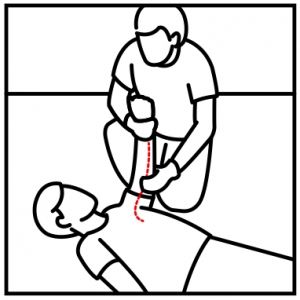Serious internal/external bleeding
 Serious bleeding must be stopped as quickly as possible. External bleeding by applying pressure to the wounds, internal bleeding by surgical intervention. Bleeding comes about through sharp or blunt trauma. Internal bleeding in particular can remain undetected for a long time.
Serious bleeding must be stopped as quickly as possible. External bleeding by applying pressure to the wounds, internal bleeding by surgical intervention. Bleeding comes about through sharp or blunt trauma. Internal bleeding in particular can remain undetected for a long time.
Symptoms are
- Heavy, even spurting bleeding out
- Stomach ache
- Dizziness, weakness
- Impaired consciousness
- Shortness of breath
- Paleness, feeling cold, cold to the touch
First Aid means here
- Move the patient as little as possible, let standing patients sit down
- Stop external bleeding by applying pressure to the wound
- Hold the affected extremity up high (get someone to hold it up)
- Apply pressure to the incoming artery (inside the upper arm, groin)
- Apply a compression bandage
- Dial the emergency number 144 (get someone else to dial it)
- If internal bleeding is expected ensure the patient is hospitalised as quickly as possible by the emergency services
Please also note
If there is significant bleeding out, then stop the bleeding immediately. For this use, e.g. the patient’s hand, your hand (with gloves), some kind of object such as a cloth, paper and medical gauze as soon as available. Internal bleeding is often difficult to identify. If a significant force could have impacted on the chest, stomach and / or pelvis then the person concerned must immediately be taken to hospital by ambulance. Who heals the patient there? The surgeon in the operating theatre but only if the patient arrives in time.
Advanced subjects
Pelvic fracture
Compression bandage
Splenic rupture